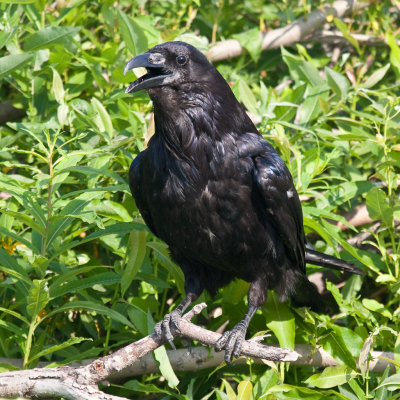Habitat
Where does the common raven live?

The common raven population is incredibly extensive and widespread; it can be found thriving in numerous habitats located on four continents (Goodwin 1986). The ability of flight allows for a large distribution of this bird; it is established throughout many parts of North America, North Africa, Asia, as well as Europe; this bird can be seen in almost all terrestrial environmental communities (Boarmen 1999). Sharing a large variety of locations with humans, human maltreatment and destructive interactions with Corvus corax may have influenced and facilitated a decline in population and distribution of this bird throughout the world (Goodwin 1986).
Migration
In general, the common raven is not a bird that migrates with the seasons. It can be seen flying in groups ranging from small to large numbers, but experts theorize that this behavior can be attributed to local movements in correlation with the need to find resources during times of drought, food shortages, or nesting locations during breeding seasons (Boarmen 1999).
Habitat
Habitats of this creature include boreal, coniferous, and
deciduous forests, tundra (Greenland, North Asia, and Northern parts
of North America), deserts and desert
 fringes (North Africa and
Middle East), mountain ranges, prairies and farmland, coastal
shorelines, and high mountain ranges. Temperatures within these
differing habitats may vary from -50 degrees Celsius in the Arctic
to 45 degrees Celsius on the fringes of deserts. Although
generally preferring open, mountainous and coastal areas, Corvus
corax can also be found living in close vicinity to human
cities, landfills, highways, as well as buildings which can be used
for nesting (Boarmen 1999).
fringes (North Africa and
Middle East), mountain ranges, prairies and farmland, coastal
shorelines, and high mountain ranges. Temperatures within these
differing habitats may vary from -50 degrees Celsius in the Arctic
to 45 degrees Celsius on the fringes of deserts. Although
generally preferring open, mountainous and coastal areas, Corvus
corax can also be found living in close vicinity to human
cities, landfills, highways, as well as buildings which can be used
for nesting (Boarmen 1999).
Ecological Niche
The ecological niche of an organism is very closely associated with the habitat that it lives in. By definition, the ecological niche describes the specific “job” that a creature performs within its habitat and how it “fits in” with the environment where it can be found (Campbell 2008). Corvus corax has a very large but seemingly straight forward niche within its habitats. A very versatile omnivore, the common raven can act as a scavenger of garbage and dead animal carcasses, a predator of small chordates such as mice and small birds, or even gatherers of grains from land plants. By eating such a wide range of organisms, the common raven is an important factor in regulating the number of animals that it preys upon, cleaning up pollution from garbage and dead carcasses, as well as facilitating the spread of plant seeds within its ecosystem. Although primarily feeding on other organisms, juvenile common ravens may also fall prey to and be a food source for other common ravens, Great Horned Owls, Golden Eagles, and hawks (Boarmen 1999).
Click Here to see the common raven in one of its many habitats!
Click Here to witness the common raven in its ecological niche scavenging from a boar carcass!
Go to Adaptations to see how the common raven has adapted to its many habitats!
Back to Top
Back to Homepage

